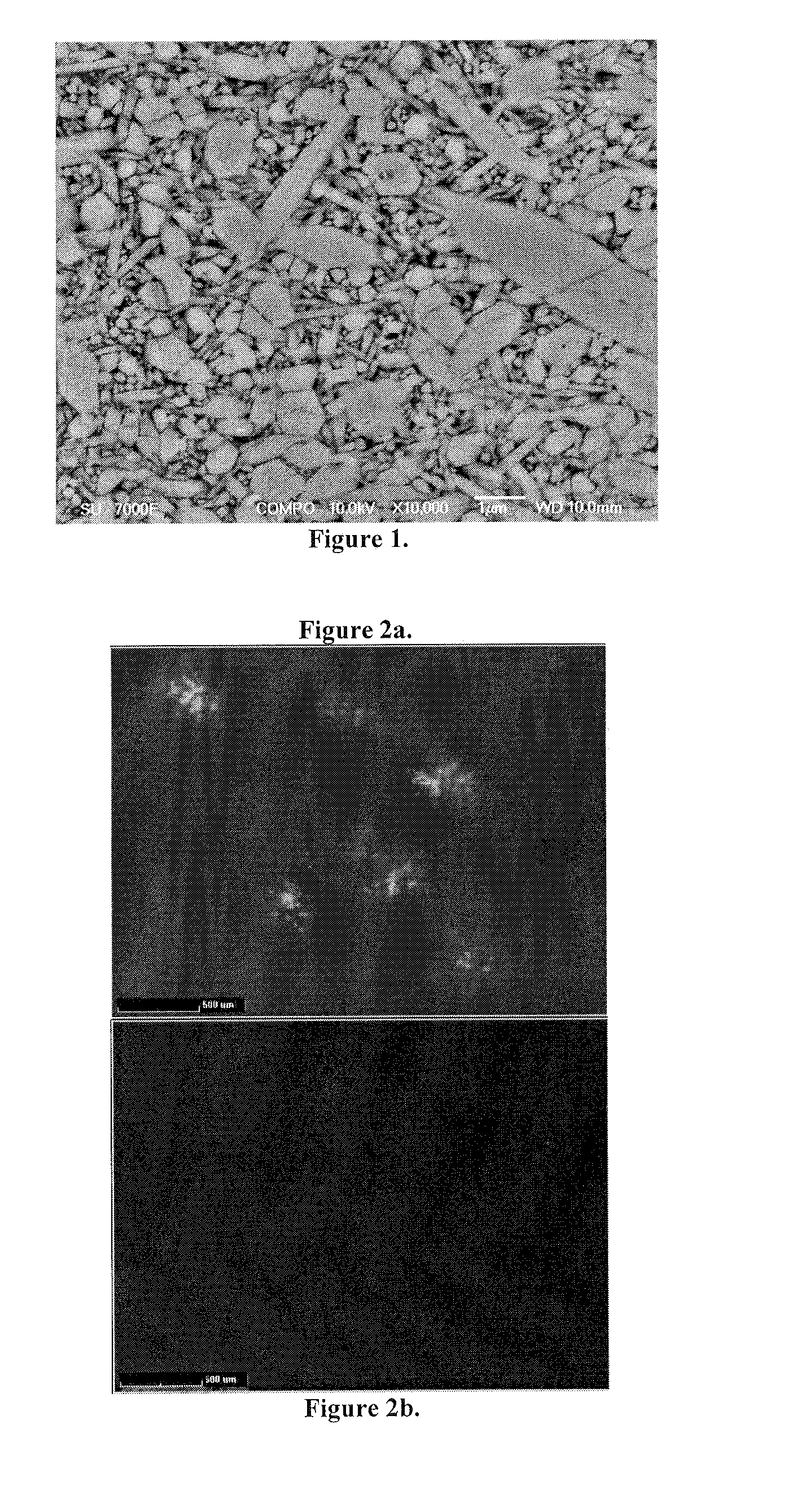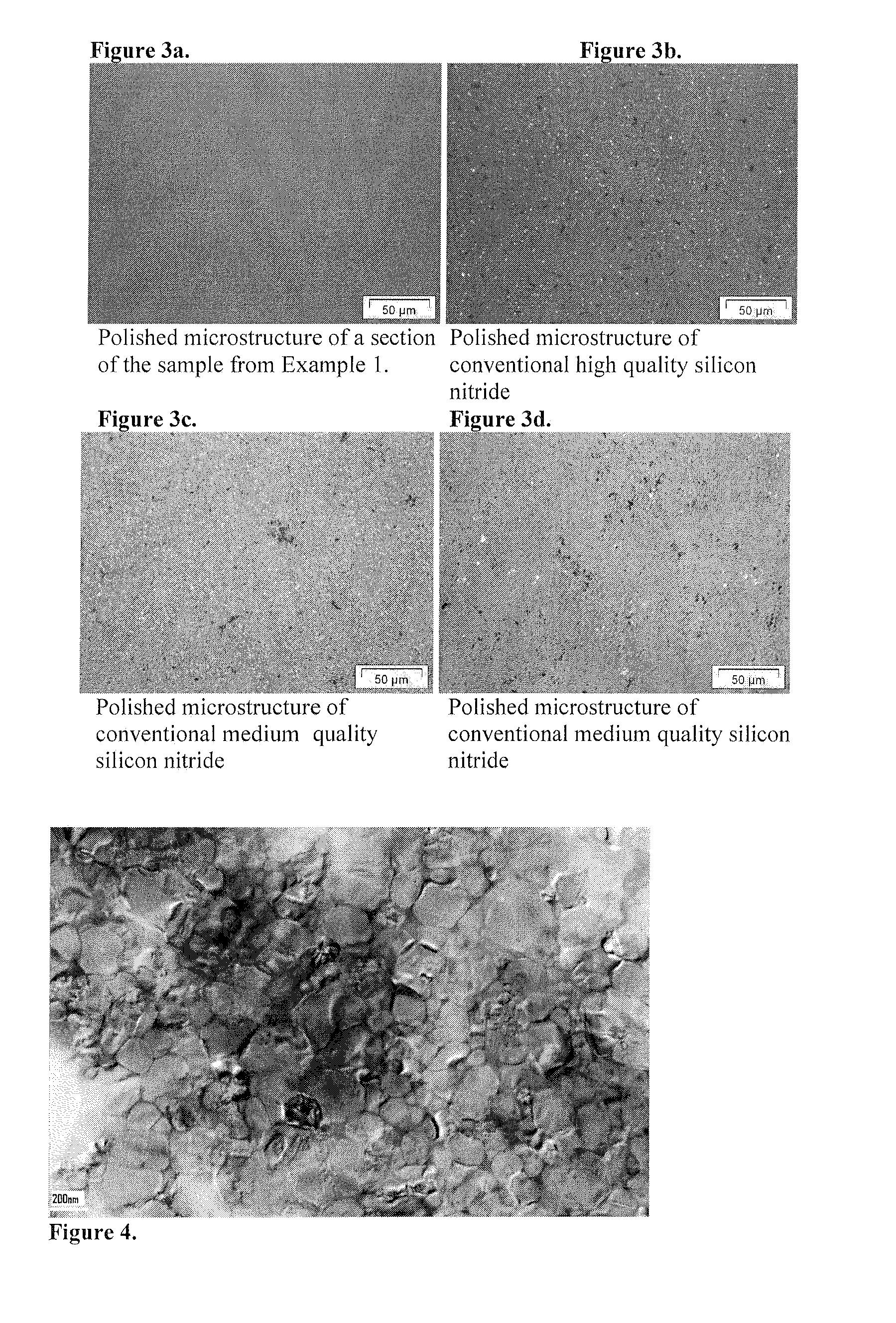Large ceramic component and method of manufacture
a technology of sintered ceramics and components, applied in the direction of synthetic resin layered products, electric/magnetic/electromagnetic heating, mechanical instruments, etc., can solve the problems of high and local stress on contacting parts, contacting parts are also exposed to various lubrication, contamination and temperature conditions,
- Summary
- Abstract
- Description
- Claims
- Application Information
AI Technical Summary
Benefits of technology
Problems solved by technology
Method used
Image
Examples
example 1
[0048]A powder was produced through mixing of 91 wt % Si3N4 (d502O3 (d506O2N6 (d50−1 was applied. The sample was first densified at 1550° C. for three minutes and thereafter treated at a a second temperature of 1730° C. for five minutes. The temperature was measured with an optical pyrometer focused on the surfaces of the sintering die. The sintering took place under vacuum. The pressure was kept at 50 MPa during the first densification step and was lowered to 5 MPa in the second temperature treatment step.
[0049]A sialon component was formed with a Vicker's hardness, HV10, of about 1800 kg mm−2 and a fracture toughness, K1c, of 6.4-6.8 MPa·m1 / 2. Anisotropy on the fracture indentation toughness was checked and less than 5% between the direction parallel and perpendicular to the pressure direction, the weakest direction still showed minimum fracture indentation toughness above 6 MPa·m1 / 2. 4-point bending strength was estimated, from bi-axial strength tests, to about 810 MPa with a Wei...
example 2
[0051]A powder was produced through mixing of 91 wt % Si3N4 (d502O3 (d50 6O2N6 (d50−1. The sample was densified at 1650° C. for 30 minutes. The temperature was measured with an optical pyrometer focused on the surfaces of the sintering die. The sintering took place under vacuum. The pressure was kept at 40 MPa.
[0052]A sialon component was formed with a Vicker's hardness, HV10, of about 1700 kg mm−2 and a fracture toughness, K1c, of about 6.7 MPa·m1 / 2. Anisotropy on the fracture indentation toughness was checked and less than 11% between the direction parallel and perpendicular to the pressure direction, the weakest direction still showed minimum fracture indentation toughness above 5.7 MPa·m1 / 2. The microstructure showed no visible pores under optical microscopy up to a magnification of 200× on polished samples, limited or no secondary phase and no snowflakes. Only a small 5 mm diameter area in the very core of the component showed few pores with sizes up to 10 μm and a pore fractio...
example 3
[0054]A powder was produced through mixing of 91 wt % Si3N4 (d502O3 (d506O2N6 (d50−1. The sample was densified at 1600° C. for 30 minutes. The temperature was measured with an optical pyrometer focused on the surfaces of the sintering die. The sintering took place under vacuum. The pressure was kept at 40 MPa.
[0055]A sialon component was formed with a Vicker's hardness, HV10, of about 1700 kg mm−2 and a fracture toughness, K1c, of 7 MPa·m1 / 2. Anisotropy on the fracture indentation toughness was checked and less than 11% between the direction parallel and perpendicular to the pressure direction, the weakest direction still showed minimum fracture indentation toughness above 5.7 MPa·m1 / 2. The microstructure showed no visible pores under optical microscopy up to a magnification of 200× on polished samples, limited or no secondary phase and no snowflakes. Only a small 7 mm diameter area in the very core of the component showed few pores with sizes up to 10 μm and a pore fraction volume ...
PUM
| Property | Measurement | Unit |
|---|---|---|
| diameter | aaaaa | aaaaa |
| time | aaaaa | aaaaa |
| pressure | aaaaa | aaaaa |
Abstract
Description
Claims
Application Information
 Login to View More
Login to View More - R&D
- Intellectual Property
- Life Sciences
- Materials
- Tech Scout
- Unparalleled Data Quality
- Higher Quality Content
- 60% Fewer Hallucinations
Browse by: Latest US Patents, China's latest patents, Technical Efficacy Thesaurus, Application Domain, Technology Topic, Popular Technical Reports.
© 2025 PatSnap. All rights reserved.Legal|Privacy policy|Modern Slavery Act Transparency Statement|Sitemap|About US| Contact US: help@patsnap.com



